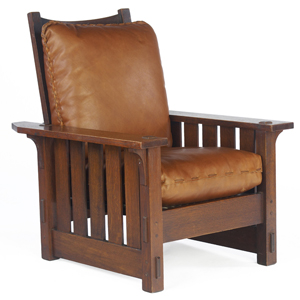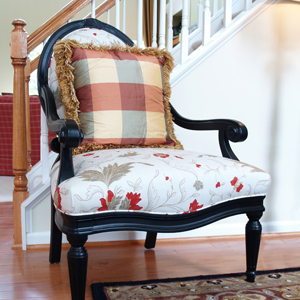 |

Morris chairs, such as this one, showcase the clean lines and simplicity the Arts & Crafts movement embodied.

Transitional is today's catch-all style category. It's a blend of traditional and contemporary, and provides a good starting place for people trying to define their style.

This vintage Eames chair is an example of mid-century modern design.
This vintage Eames chair is an example of mid-century modern design.
On-Staff Style Experts
Not sure you can tell the difference between Arts & Crafts and Americana? No problem; most home furnishings retailers offer some level of in-store design assistance, with many having trained interior designers on-staff.
-
Furniture Style Basics: Present Day
An easy-to-understand guide to today's most popular home furnishings styles.
- by Sam Gaines
While it's difficult to classify today's broad range of home furnishings into just a few groups, there are some generally recognized categories. These styles are a kind of shorthand that may help you describe your likes and dislikes to an interior designer or sales associate during your design or shopping process.
We outlined the history of furniture styles in our article Furniture Style Basics: Historic. Now we pick up where those historic styles left off, and focus on the styles you're most likely to see today.
Present Day (Including Traditional, Contemporary & Modern, Country & Cottage, Asian, Bohemian, Hollywood Regency & Mid-century Modern, Arts & Crafts/Mission, and Transitional categories)
Traditional
-
European: Today, European Traditional style can be a reproduced version of any of the styles already mentioned above—or some combination of distinct styles. Generally, modern European Traditional style will follow the Rococo or Neoclassical periods’ keynotes. Curvilinear designs and dark woods are common, as are arched sofa backs and a formal feel.
-
American: Likewise, American Traditional style of the present day looks back to the Colonial and Empire periods, while adapting those themes to modern sensibilities. Painted finishes and architectural flourishes, such as spindles and finials, are very typical.
-
British Colonial/West Indies: A tropical feel infuses the British traditions to create the British Colonial and West Indies look. Wicker, rattan, and other lighter woods (with deep finishes) replace the hardwoods of typical British furniture and lines are cleaner and simpler.
Contemporary & Modern
-
Urban/Loft: Lines often flare, but keep their simplicity and functional feel in the urban and loft styles of Contemporary furniture. Leather and Microfiber are popular choices for upholstery.
-
Danish/Scandinavian: The Norse influence in Contemporary furnishings continues with no signs of flagging. Simple, unadorned pieces of walnut and teak are very common. Contemporary Scandinavian designers employ straight lines with only occasional, gentle curves.
-
Minimalist: Minimalist home furnishings take Contemporary simplicity to an extreme. Inspired most directly by Bauhaus design, simple lines dominate the Minimalist approach. The emphasis is on free space, functionality and economical design, rather than flourishes in furnishing interior space.
Country & Cottage
-
Americana: A simple yet substantial style, Americana design emphasizes natural woods and deep finishes. Ornamentation is kept to a minimum. Fabrics tend toward muted colors, with a comfort in look and feel. Patriotic themes such as stars and stripes and colors such as brick red, off-white and navy are often incorporated.
-
Cottage: This variation on Country style takes its lead from the garden and natural surroundings, adding bead board to wicker and iron to soften the look. Cotton and linen upholstery in floral or checked patterns is common.
-
French Country: Also known as “French Provincial,” this style approach adds a light touch of ornamental flourish to the casual sensibility of Country design. French Country often takes classic French furniture design and lightens it considerably, opting for cane or rush seats (rather than heavy upholstery). Blue, gold and rust are popular colors, and Toile patterns are favorites as well.
-
Shabby Chic: This eclectic style uses a white or off-white base to complement floral colors and even found objects and folk art. Slipcovers are a familiar accent to Shabby Chic pieces.
-
Coastal: Reminiscent of a beach house, classic coastal style embraces natural materials and favors a relaxed approach. Some designs include artwork and accessories featuring nautical themes, while others purposefully do not. Coastal style variations include: Pacific Coast design which tends to incorporate Asian influence with deep finishes and comfortable fabrics; Atlantic Seaboard builds on classic Colonial style with louvers and shutters, as well as a color palette reminiscent of lighthouses; and Gulf Coast style fuses Art Deco inspiration with vibrant colors, wicker and rattan.
-
Rustic/Lodge: Earth tones pervade the color palette of both the Rustic and Lodge styles. Exposed wood, often in light finishes are popular, as are accents of Native American artwork, nature-inspired accessories, and iron-and-wood carvings as accents. Fabrics tend to have a hand-woven feel.
Asian
What is often referred to broadly as Asian design points primarily to the traditions and influences of Japanese and Chinese styles. Silk plays a paramount role in the texture of Contemporary Asian pieces, as do mid-tone woods and dark lacquer finishes. Bamboo is sometimes incorporated, as are other hints of nature’s influence. Graphics and textiles often feature cherry blossom and lotus flower motifs.
Bohemian
European folk art and gypsy culture heavily influence the unique look of Bohemian home furnishings. The color palette is intensely, deeply colorful, with jewel tones playing a featured role. Embroidered fabrics and fringed details further mark the style.
Hollywood Regency & Mid-century Modern
Hollywood Regency style brings lavish, luxurious fashion appointments to home furnishings. Overstuffed furniture, lush velvets and thick carpets abound in this design format. By contrast, bold, broad rectilinear shapes mark the Mid-Century Modern style, which takes the Bauhaus credo of “form follows function” to a domestic setting. Smooth, refined finishes are de rigueur for this style category.
Arts & Crafts/Mission
Painstaking craftsmanship marked the Arts & Crafts movement in American home furnishings. The overall design is simple and understated, while the workmanship is evident in the intricately detailed wood inlays and balanced forms. The Mission style added a distinctive Spanish flavor to Arts & Crafts themes.
Transitional
For a large variety of home furnishings pieces that don’t comfortably fall under any one style category—as well as pieces that blend elements from various style categories—there is the Transitional label. Representing a blend of Traditional and Contemporary styles, Transitional looks tend to be less ornate and formal than Traditional ones—yet not as severe and defined as Contemporary styles. Transitional also can refer to a style preference based on life stage—as the starting place to discovering what style you ultimately prefer. Upholstered chairs and sofas as well as occasional tables frequently bear the transitional title.

